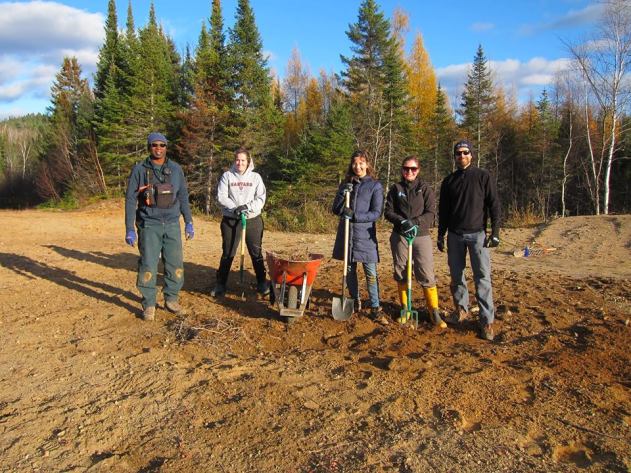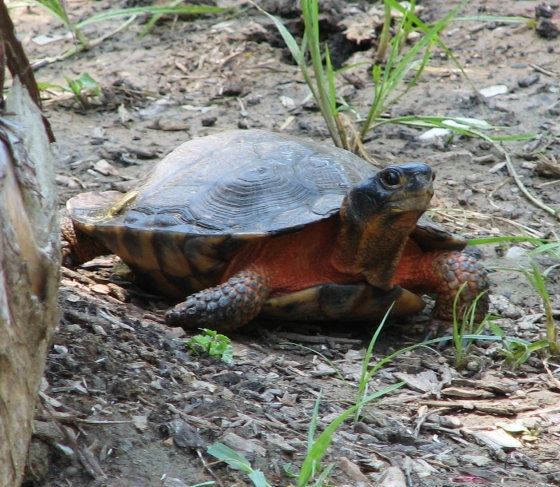The cold winds of Fall are sweeping Quebec already, and I though I would share with you all a glamorous day in the world of wood turtle conservation.
It can’t all be Hawaiian sunshine and Mai Tais, right?
On this day last year:
My right hand has stiffened into a claw, and my muscles are sore in odd places from misuse. The other volunteers are in a similar state. I sweep my eyes over the sandy clearing we’ve weeded by hand over the course of 8 hours, chilled by a brutally cold October wind.
“I hope this helped,” says Jessica a fellow student volunteer, her voiced strained with fatigue.
“It certainly can’t hurt,” I reply. “If there are any turtles left in the area, at least they’ll have a proper nesting site.”
We make our way to the truck, dragging shovels and our feet. A hot shower will be our reward after the long drive home.

Long drive home from where? I can’t say: this particular area is a secret. When we left Montréal’s Ecomuseum early that morning, only the Coordinator for Research and Conservation Sebastian Rouleau knew the exact coordinates. He gave the vague instructions of “near Shawingan,” a town three hours away.
Earlier that week, Sebastian called upon the Ecomuseum’s staff and volunteers, hoping they would spare their day off to help him with a wood turtle conservation project.
See, it takes a special kind of person to volunteer for hours of backbreaking labour in an undisclosed remote location. The kind of person who love turtles, yes and who wishes to contribute in maintaining one of Québec’s rare reptile species—and maybe someone a little crazy too. Many joined. For the wood turtles.
Wood turtles are a mostly terrestrial species found in Eastern Canada, from Ontario to Nova Scotia, in small, increasingly disjointed populations. It’s a medium size turtle with an attractive sculpted shell, orange legs and an expressive face. They’re cute, as turtles go.
Unfortunately, their appearance and lack of aggression make them popular pets— a significant threat to these turtles is collection for the illegal pet trade. Though longlived, they are difficult to breed, as they don’t start laying eggs until they’re 18 years old. Classified as Endangered on the IUCN’s Red List, their numbers are still in steady decline.
A sharp, sudden disappearance of turtles from an area indicates their discovery by poachers. International conventions restrict exportation but not importation on the international wildlife market. To protect wood turtles, nesting sites such as the one we cleared today are discreetly hidden.

If the need for secrecy is so great, what brought a group of overly enthusiastic conservationists to such a “need to know only” kind of place? Wood turtles are facing habitat loss. That’s the problem for amphibians and reptiles around the world, that living near humans will cause changes in their environment.
Wood turtles need sunny, easy to dig spots near water to lay their eggs. Many nesting sites are lost when streams and rivers are altered. Our site is no exception, and year after year the surrounding vegetation has been increasingly colonising the sandy riverbank, once cleared of plants by annual spring flooding.
So we got on our knees, dug in our spades and wiggle out as many roots as we can. A few times, we uncover shell fragments, a welcome sign that wood turtles were born this year. Sebastian is still wary, as there are less such signs than he hoped. But we keep weeding.
The mood is rather sober in the Ecomuseum’s truck as our dusty gang slump together for the return journey. I contemplate my calluses and reflect on the odd way I had chosen to spend my free time. Despite my aches, I can’t help but feel it was completely worth it. I’m not alone.
I ask if the volunteers would return next year, and the answer is a resounding, impassioned “YES!” We laugh, me and these invested scientists, these concerned citizens. As biodiversity constitutes millions of species interacting together to form a whole, creating a balance, so the preservation of Nature is the result of a multitude of small actions, of factions with missions, working towards a common goal.
Every little bit helps.
This post was kindly edited with the help of Carl Bindman, creative director at The Link Newspaper.

One thought on “The Secret Sandpit”